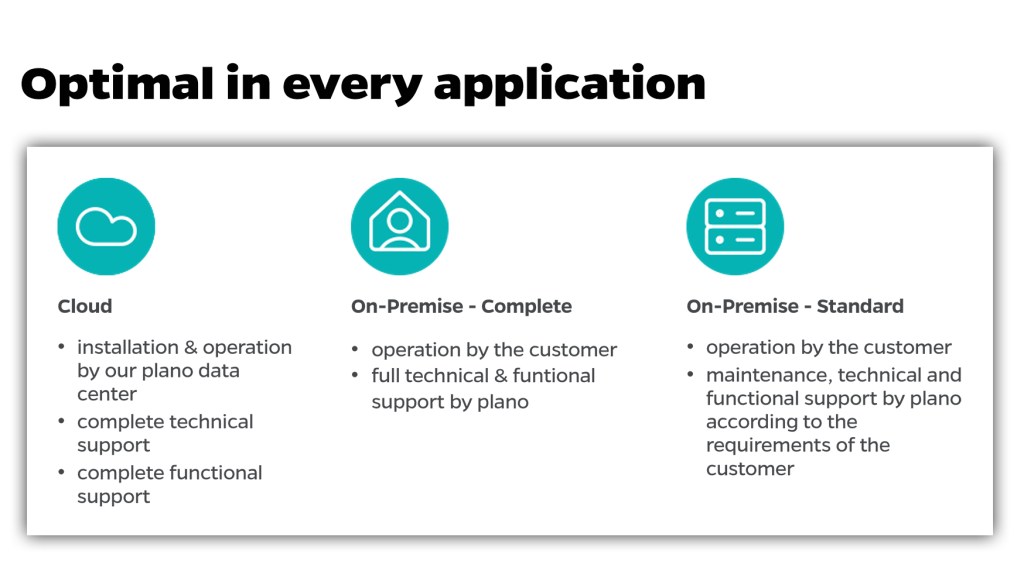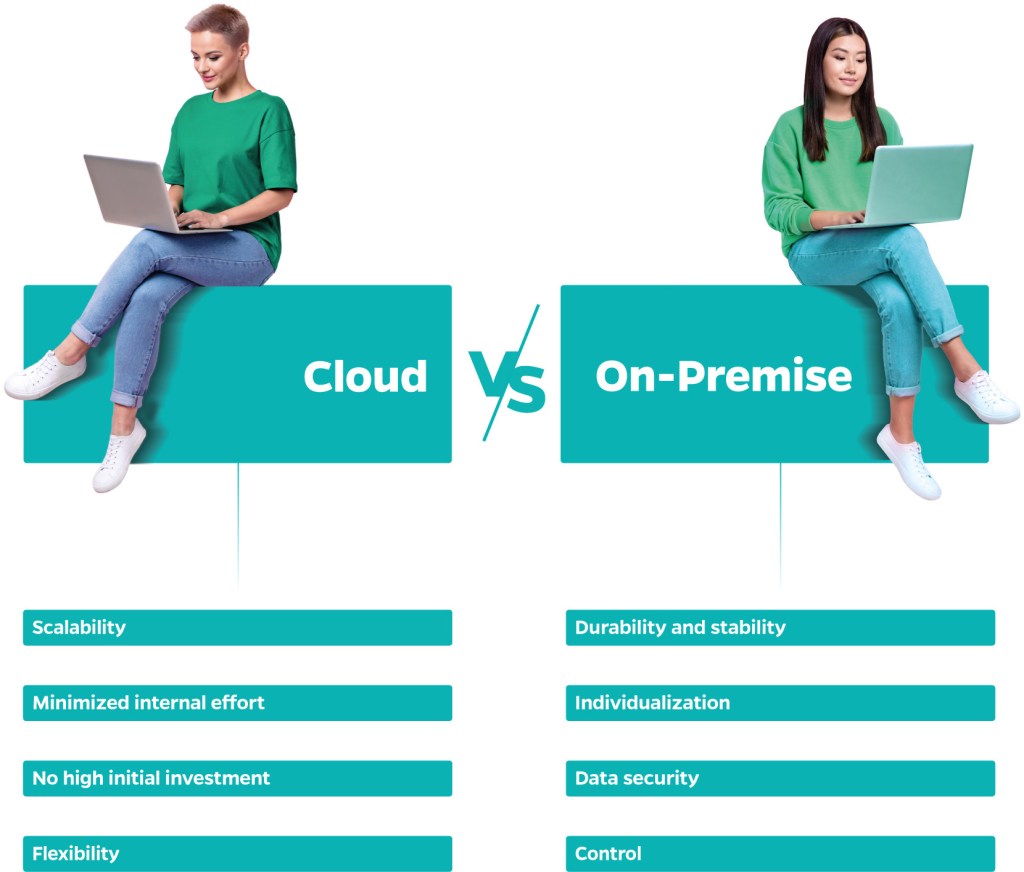Cloud vs. On-Premise? What Questions do Companies Have When Deciding on a Suitable Operating Model For Their Workforce Management Software?

The choice between a cloud or on-premise workforce management (WFM) solution is a strategic decision that has an impact on efficiency, security and flexibility. Both approaches offer advantages and disadvantages. In this article, we answer important questions that companies ask themselves when deciding on an operating model.
Contents
↓ What is a cloud and why is it relevant for workforce management?
↓ What distinguishes an on-premise solution and when is it the better choice?
↓ How do you find the right balance between cloud vs. on-premise? Or is the solution: hybrid?
What is a cloud and why is it relevant for workforce management?
The cloud is much more than just a buzzword in the IT world. It refers to an infrastructure in which data and software applications are not stored locally on the servers of a company or organization, but externally in so-called data centers that are accessible via the internet. This enables companies to scale their resources flexibly, react quickly to new requirements and at the same time benefit from maintenance and support from specialized providers.
In the classic cloud model, there are different types of provision: the private cloud, in which the infrastructure is operated exclusively for companies, the public cloud, in which resources are shared with other customers, and the hybrid cloud, which combines both models.
The best-known cloud providers include leading global companies such as Amazon Web Services (AWS), Microsoft Azure and Google Cloud Platform (GCP). These offer comprehensive services, from Infrastructure-as-a-Service (IaaS) to Platform-as-a-Service (PaaS) and Software-as-a-Service (SaaS).
The cloud is particularly relevant for companies operating in the workforce management sector. Cloud-based workforce management tools make it possible to manage all relevant data and processes centrally and offer the advantage that they can be accessed at any time and from anywhere. Whether in the office, working from home or on the move. Flexibility is crucial to ensure efficient workforce scheduling.
Another aspect that is important for companies is data security. In an increasingly globalized world, companies are often looking for solutions that can be hosted either in Germany or in Europe to meet regional data protection requirements.
This is where plano offers a flexible solution. We work with various cloud providers and enable our customers to host their data locally or in different regions as required, always adapted to their specific security requirements.

It is important to understand that the term “cloud” often has a different meaning among the general public. Many users first think of the storage of personal data, such as photos or documents, when they hear the term cloud. However, the cloud as an operating model in the corporate context is much more comprehensive: it not only enables data to be stored and managed but also allows companies to organize their IT resources in a cost-effective, scalable and flexible manner.
What distinguishes an on-premise solution and when is it the better choice?
An on-premise solution means that the software is installed and operated directly on your company’s servers. This variant is considered particularly secure, as all data is stored exclusively in-house. This is often a decisive advantage for companies operating in highly regulated industries, such as the healthcare or financial sectors.
Another advantage is complete control. You can decide individually when updates are carried out and have direct access to your systems. This makes on-premise solutions ideal for companies with specific requirements that cannot be covered by standard solutions. However, these advantages come with challenges: An on-premise solution requires its own IT infrastructure as well as a team to take care of maintenance, updates and security. In addition, the acquisition costs for software are often higher at the time of investment than with a cloud model, as hardware and licenses must be paid for in advance.
How do you find the right balance between cloud vs. on-premise? Or is the solution: hybrid?
Not every company necessarily has to choose between cloud and on-premise. Hybrid approaches offer the opportunity to use the best of both worlds. For example, you can store sensitive data such as personnel data on your own server, while less critical applications such as shift scheduling or time recording are operated in the cloud.
Another decisive factor is support. For both cloud and on-premise, you should ensure that your provider offers a comprehensive service. Especially with workforce management software, which plays a central role in your company, fast and competent support is essential.
We will be happy to help you: https://plano-wfm.com/en/support/
What advantages does the cloud solution offer?
Cloud solutions offer a high degree of flexibility and scalability, as costs are often billed per user and month. This makes costing easier and reduces the initial investment outlay, which is particularly beneficial for companies that want to dynamically adapt their IT resources. In addition, the provider usually takes over the maintenance and updating of the infrastructure, which minimizes the internal effort for the company. The cloud is therefore ideal for companies looking for an agile solution that can be easily adapted to growing or changing requirements.
In the long term, a cloud solution may incur higher costs if used over many years, as monthly fees increase over time. Nevertheless, for many companies, the cloud offers the advantage of a lower barrier to entry, as no high initial investment is required. The cloud also makes it easier to switch software solutions, as companies are not tied to large investments once they have made them. This ensures greater flexibility and adaptability.
What advantages does the on-premise solution offer?
On-premise solutions offer the advantage of full control over data and infrastructure. Companies can design their systems according to their own needs and are not dependent on external providers. This is particularly important for companies that have high data security and compliance requirements. In addition, an on-premise solution enables stable and long-term use without ongoing monthly costs, which can reduce costs per year in the long term. However, an on-premise option requires a higher initial investment as well as in-house responsibility for maintenance, updates and security management, which can be associated with a higher administrative burden.

How does a hybrid solution help to combine the advantages of both approaches?
For companies that want to combine the advantages of both worlds, a hybrid solution is an attractive option. It makes it possible to keep sensitive data and applications in their own infrastructure while outsourcing less critical processes or additional capacities to the cloud. This flexibility offers companies the opportunity to optimize their IT structure according to their needs and specific requirements without compromising on control or scalability.
Conclusion
The choice between cloud and on-premise depends on the individual requirements of your company. Small and medium-sized companies often benefit from the flexibility and cost efficiency of the cloud. Large corporations and industries, on the other hand, often rely on on-premise solutions to retain control of their data. A hybrid solution can create the perfect balance between security and flexibility. It is important that you analyze your requirements carefully in advance.
plano solutions gmbh offers its customers the right solution from all three worlds. Whether cloud, on-premise or hybrid, we work with you to find the right path for your company and advise you on the best possible operating model for your business.
In doing so, we place a clear focus on flexibility and customized solutions for companies in a wide range of industries. While many providers specialize in just one solution, we offer you the opportunity to choose the option that best suits your business goals and IT requirements, depending on your needs and requirements.
Our experienced team is always on hand to provide you with expert advice to help you find the optimal solution. We will accompany you on the path to an efficient and future-proof IT strategy.
Would you like to find out more?
Further information about our workforce management software and the areas of application can be found here:
→ Workforce Management from plano
Archive
Employee Retention in Retail
We’re Here for You
